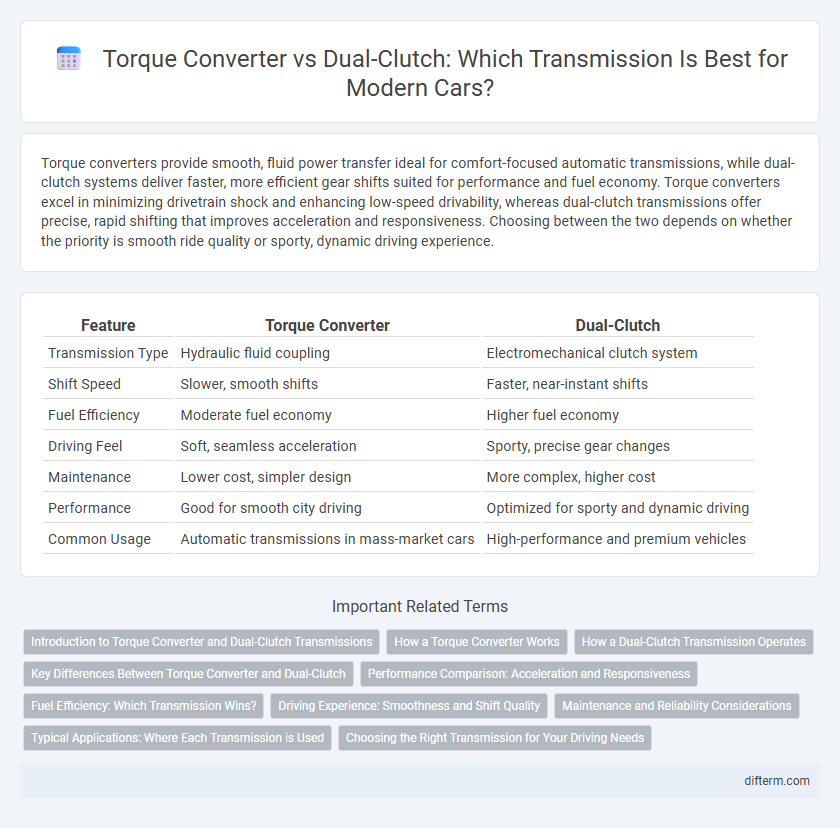Torque converters provide smooth, fluid power transfer ideal for comfort-focused automatic transmissions, while dual-clutch systems deliver faster, more efficient gear shifts suited for performance and fuel economy. Torque converters excel in minimizing drivetrain shock and enhancing low-speed drivability, whereas dual-clutch transmissions offer precise, rapid shifting that improves acceleration and responsiveness. Choosing between the two depends on whether the priority is smooth ride quality or sporty, dynamic driving experience.
Table of Comparison
| Feature | Torque Converter | Dual-Clutch |
|---|---|---|
| Transmission Type | Hydraulic fluid coupling | Electromechanical clutch system |
| Shift Speed | Slower, smooth shifts | Faster, near-instant shifts |
| Fuel Efficiency | Moderate fuel economy | Higher fuel economy |
| Driving Feel | Soft, seamless acceleration | Sporty, precise gear changes |
| Maintenance | Lower cost, simpler design | More complex, higher cost |
| Performance | Good for smooth city driving | Optimized for sporty and dynamic driving |
| Common Usage | Automatic transmissions in mass-market cars | High-performance and premium vehicles |
Introduction to Torque Converter and Dual-Clutch Transmissions
Torque converters and dual-clutch transmissions (DCT) represent two distinct types of automotive transmission technologies designed to transfer engine power to the drivetrain. Torque converters utilize a fluid coupling to provide smooth acceleration and torque multiplication, making them ideal for traditional automatic transmissions with seamless gear shifts. Dual-clutch transmissions feature two separate clutches for odd and even gear sets, enabling faster gear changes and improved fuel efficiency, often favored in performance-oriented and modern automatic vehicles.
How a Torque Converter Works
A torque converter uses a fluid coupling to transfer engine power smoothly to the transmission, allowing the engine to spin somewhat independently of the transmission input shaft. It consists of three main components: the impeller, turbine, and stator, which work together to multiply torque and provide a variable drive ratio. Unlike a dual-clutch transmission that relies on mechanical clutches for direct gear engagement, the torque converter offers seamless acceleration with reduced engine stalling and smoother power delivery at low speeds.
How a Dual-Clutch Transmission Operates
A dual-clutch transmission operates using two separate clutches that manage odd and even gear sets, enabling seamless gear shifts without interrupting power flow. This system alternates between clutches to preselect the next gear while the current gear is engaged, resulting in faster acceleration and improved fuel efficiency compared to traditional torque converters. By eliminating torque converter slip, dual-clutch transmissions enhance vehicle responsiveness and offer smoother driving dynamics in automotive applications.
Key Differences Between Torque Converter and Dual-Clutch
Torque converters use fluid coupling to transmit engine power smoothly and provide torque multiplication, making them ideal for automatic transmissions with seamless acceleration and reduced stalling. Dual-clutch systems employ two separate clutches for odd and even gears, delivering faster gear shifts and improved fuel efficiency, favored in performance and manual-automatic hybrid vehicles. The main differences lie in torque delivery method, shift speed, and overall driving dynamics, with torque converters emphasizing smoothness and dual-clutch systems focusing on speed and control.
Performance Comparison: Acceleration and Responsiveness
Torque converters offer smoother acceleration due to their fluid coupling, but they tend to have slower responsiveness compared to dual-clutch transmissions (DCT). Dual-clutch systems provide rapid gear shifts with minimal power interruption, significantly enhancing acceleration and driving dynamics. For high-performance vehicles, DCTs deliver superior responsiveness and quicker acceleration times, making them preferable over traditional torque converters.
Fuel Efficiency: Which Transmission Wins?
Torque converters generally produce lower fuel efficiency due to fluid coupling losses, which cause energy dissipation and reduced power transfer. Dual-clutch transmissions (DCTs) deliver better fuel economy by enabling quicker, seamless gear shifts and minimizing power interruption during acceleration. Studies show that vehicles equipped with DCTs can improve fuel efficiency by up to 10-15% compared to traditional torque converter automatics.
Driving Experience: Smoothness and Shift Quality
Torque converters deliver smooth acceleration by using fluid coupling, minimizing gear shift shock and providing seamless power transfer during variable driving conditions. Dual-clutch transmissions offer rapid, precise gear changes with minimal interruption in torque flow, enhancing responsiveness and sporty driving feel. Both systems optimize shift quality, with torque converters favoring comfort and dual-clutch setups emphasizing performance.
Maintenance and Reliability Considerations
Torque converters require less frequent maintenance due to their simpler, more robust hydraulic design, offering greater durability in stop-and-go traffic conditions. Dual-clutch transmissions demand more frequent software updates and clutch replacements, as their complex mechanical systems are more sensitive to wear under aggressive driving. Reliability for torque converters generally surpasses dual-clutch systems in harsh environments, while dual-clutch units offer quicker, more precise shifts at the cost of higher maintenance frequency.
Typical Applications: Where Each Transmission is Used
Torque converters are commonly used in traditional automatic transmissions for passenger vehicles and heavy-duty trucks due to their smooth power delivery and ability to handle higher torque loads. Dual-clutch transmissions are favored in sports cars and performance vehicles for their faster gear shifts and improved fuel efficiency. Fleet vehicles and commercial applications requiring durability often rely on torque converters, while dual-clutch systems dominate high-performance and luxury automotive markets where responsiveness is critical.
Choosing the Right Transmission for Your Driving Needs
Torque converters provide smooth, consistent power delivery ideal for everyday city driving and heavy traffic conditions, optimizing fuel efficiency and comfort. Dual-clutch transmissions offer faster, more precise gear shifts that enhance performance and acceleration, making them perfect for sporty driving and high-performance vehicles. Selecting the right transmission depends on prioritizing comfort and fuel economy or dynamic responsiveness and driving engagement.
torque converter vs dual-clutch Infographic

 difterm.com
difterm.com